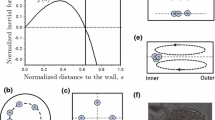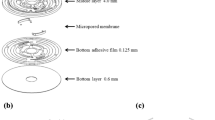Abstract
Rice is one of the world’s important food crops, but its output is affected by disease all year round. Among them, the pathogens of rice smut and sheath blight are the two most typical fungal pathogens infesting rice. Therefore, the detection of pathogenic spores is very important for studying the occurrence and development of rice diseases. In this paper, a microfluidic chip for the separation of spores of rice smut is designed. The microfluidic chip adopts a two-stage separation structure. The first-stage separation structure adopts a periodic rectangular recess structure on the side of the separation channel to achieve the purpose of separating air spores. The second-stage separation structure adopts a vertical sheath flow channel structure to enhance the separation effect. The paper used a microscope to photograph spore images to verify the separation effect. The experimental results show that the chip can complete the separation of the rice smut spores.
Access provided by Autonomous University of Puebla. Download conference paper PDF
Similar content being viewed by others
Keywords
1 Introduction
In 2006–2015, Chinese crops were frequently threatened by various pests and diseases [1]. Rice has a long history of planting in China, with an average annual planting area of 30 million hm2, accounting for about one-third of the area planted with food crops. It is one of the indispensable food crops in China [2]. However, the annual economic loss caused by the reduction of rice production caused by pests and diseases in China is between 4 million and 5 million tons [3, 4].
It has become an important means of disease prevention and control by detecting the type and content of fungal spores in the air to achieve timely warning of epidemic diseases in the air [5, 6]. The traditional methods for detecting spores of crop diseases are mainly weighing method and microscopic counting method. The results obtained by these two methods are susceptible to impurities [7].
According to the above reasons, finding a convenient and low-cost method for separating impurities has become a hot topic in current research. The microfluidic chip has the advantages of minimal consumption of reagents, rapid and automatic detection, low cost, and high degree of integration. Based on the above technology, a chip capable of efficiently performing spore separation is designed to realize rapid detection of spores.
2 Methods and Materials
2.1 Design of Microfluidic Chip
In order to achieve automatic separation of aggregated spores, a microfluidic chip comprising a two-stage structure as shown in Fig. 1a was designed. The first part is called the passive separation structure. As shown in Fig. 1b, it mainly solves the agglomeration phenomenon of air fungal spores. With the periodic collision and extrusion of the chip channel, the aggregated spores can repeatedly collide with the chip channel and decompose. The second part is called the active separation classification structure. As shown in Fig. 1c, the spores of lightweight are more susceptible to external motion and change the motion state, so a small external force perpendicular to the initial velocity direction can be introduced. Different types of spores are classified.
2.2 Numerical Method
Here is a microfluidic chip design diagram with a chip thickness of 100 μm, an entrance width of 500 μm, and an entrance from the first rectangular depression of 1000 μm in Fig. 1. The last rectangular depression is 500 μm from the inlet of the active separation structure; the width of the sheath flow inlet of the active separation structure is 200 μm, and the length of the upper channel wall is 700 μm.
It is assumed that the airflow is a stable two-dimensional flow, axisymmetric, and incompressible. The temperature was 20 °C, and the gas pressure was 101.3 kPa. The side walls of the chip were set to have no slip, the left inlet flow rate was 10 mm3/s, and the sheath flow rate was 1 mm3/s. After the airflow simulation, the particle motion was studied. Simulate particle motion used COMOSOL Multiphasic 5.1. The side walls of the chip were set to adhere, the particle density was 1000 kg/m3, and the particle diameter was 2 and 16 μm.
3 Results and Discussions
3.1 Particle Motion Simulation
First, h and L are optimized, and the simulation results are shown in Fig. 2a. The aggregate spore separation effect is best when the height of the rectangular depression is h = 0.3 mm. Therefore, the length L of the passive separation structure does not affect the separation effect, and the separation effect is best when the height h of the rectangular depression is 0.3 mm. Then, the values of n and m are optimized. The experimental results are shown in Fig. 2b. When the inter-rectangular depression m is a certain value, n = 0.4 mm, the separation effect of the aggregate spores is the best. According to the above experiment, h is 300 μm, n is 400 μm, L is the length of four continuous rectangular concave structures, and m is 0.5 mm.
Figure 2c is a flow chart of the flow rate of the microfluidic chip. Figure 2d is the particle separation case, because of the inertia, where 2 μm particles are located below the chip separation region and 16 μm particles are located above the chip separation region.
3.2 Experimental Results
Figure 3 is an image taken by scanning electron microscopy, and the rice smut spores are clearly separated.
4 Conclusions
The paper designed a microfluidic chip for the isolation of rice smut spores, including passive separation and active separation. The optimal parameters to maximize chip separation efficiency were investigated. Experiments show that the designed microfluidic chip can separate the agglomerated spores.
References
Walters DR (2013) Controlling crop diseases using induced resistance: challenges for the future. J Exp Botany 64(5):1263
Webster RK (2012) Compendium of rice diseases. Dis Compendium 84(6):953
Yang JH (2010) Diversity analysis of antagonists from rice-associated bacteria and their application in biocontrol of rice diseases. J Appl Microbiol 104(1):91–104
Zhu Y (2000) Genetic diversity and disease control in rice. Nature 406(6797):718
Zheng A (2013) The evolution and pathogenic mechanisms of the rice sheath blight pathogen. Nat Commun 4(1424):1424
Qin Z (2005) Detection of rice sheath blight for in-season disease management using multispectral remote sensing. Int J Appl Earth Obs Geoinf 7(2):115–128
Pellegrino PM (2002) Enhanced spore detection using dipicolinate extraction techniques. Anal Chim Acta 455(2):167–177
Acknowledgements
This research was financially supported by the Research on Intelligent System for Early Diagnosis of Main Strawberry Pests and Diseases Based on Deep Learning (2018kj11), Chinese National Natural Science Foundation (31701324), China Post-doctoral Science Foundation Project (2018M642182), Jiangsu Agricultural Science and Technology Innovation Fund (CX(18)3043), Outstanding Youth Science Foundation of Jiangsu province (BK20180099), Zhenjiang Dantu Science and Technology Innovation Fund (Key R&D Program-Social Development) (SH2018003), the Priority Academic Program Development of Jiangsu Higher Education Institutions (PAPD).
Author information
Authors and Affiliations
Corresponding author
Editor information
Editors and Affiliations
Rights and permissions
Copyright information
© 2021 Springer Nature Singapore Pte Ltd.
About this paper
Cite this paper
Wu, G., Chen, C., Yang, N., Hui, H., Xu, P. (2021). Design of a Microfluidic Chip for Separating Rice Disease Spores. In: Xu, L., Zhou, L. (eds) Proceedings of the 8th International Multidisciplinary Conference on Optofluidics (IMCO 2018). IMCO 2018. Lecture Notes in Electrical Engineering, vol 531. Springer, Singapore. https://doi.org/10.1007/978-981-13-3381-1_17
Download citation
DOI: https://doi.org/10.1007/978-981-13-3381-1_17
Published:
Publisher Name: Springer, Singapore
Print ISBN: 978-981-13-3380-4
Online ISBN: 978-981-13-3381-1
eBook Packages: EngineeringEngineering (R0)







